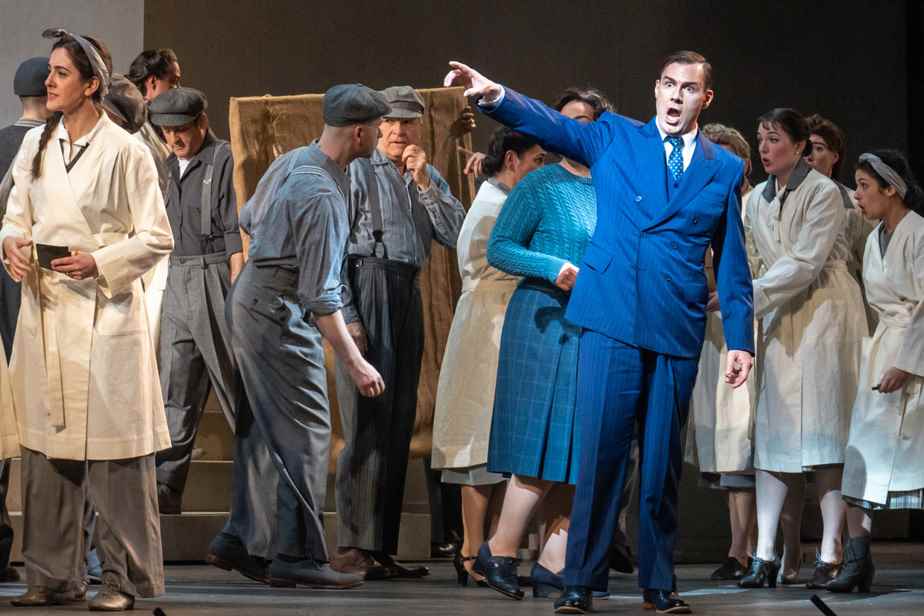Attending the birth of a major Quebec opera is a privilege, for the critics as well as for the public. All the more so with a rich work like The beauty of the world by Julien Bilodeau and Michel-Marc Bouchard, which premiered on Saturday evening at the Opéra de Montréal.
As soon as they arrived in the hall, the spectators were warned that they would experience an evening rich in emotions. Multiple signs and screens warned the public that they would see certain symbols associated with the Nazi invasion and that they might be startled by detonations (ultimately harmless recordings of gunshots played backstage without the tenth of the impact of real blanks sometimes heard in the theater).
It is surprising that this practice occurs now, after centuries of operatic murders, suicides and rapes. Especially since science points not only to the ineffectiveness of trauma warnings, but also to their probable harmfulness.
It is the proof, in any case, that art disturbs in 2022, as it disturbed – on another level – in 1940, but also in 1800, in 1400, and we could certainly go back to the caves of Lascaux in this way. .
It is also, in part, the subject of The beauty of the worldwhich recounts the rescue of works from the Louvre and thousands of others belonging to French Jews during the Second World War.
Powerful scene
In a powerful second-act scene, Hermann Göring, played with righteous perversity by tenor Matthew Dalen, comes to the famed Parisian museum to choose canvases for himself and Hitler. Those participating, according to him, in a “degenerate” art (essentially everything that comes after the Impressionists) are set aside and burned.
Because the fleeting, elusive side of modern art did not fit with the Manichaean worldview, without shades of gray, of Nazi barbarism.
For the two main characters, the director of the Louvre, Jacques Jaujard, and the curator at the Musée du Jeu de Paume, Rose Valland, art is much more than that, and they are ready to do anything to defend its transformative power.
Even if we occasionally fear for the lives of these crusaders in the shadows, it is really the integrity of the masterpieces of the Louvre and elsewhere that keeps us in suspense throughout the three acts. Who would have thought that unboxing a fake Mona Lisa or the canning of the Victory of Samothrace would give rise to such great theatrical emotion?
Especially since the creators take us straight into the mystery of creation with a magnificent prologue taking place in 1924 when Matisse painted his Woman sitting for the Jewish art dealer Rosenberg, who gave it to his very young son. The child who then appears holding an empty frame during the epilogue symbolizes the Rosenberg descendants, who will only recover the canvas in 2012…
Because it is also a question of the present in this work, especially at the very end of the opera, in a vibrant climax that we leave to the readers the pleasure of discovering.
We can, however, reveal everything about the general quality of the interpretation, despite some relatively benign reservations. The Orchester Métropolitain, which had taken its place in the pit under the direction of Jean-Marie Zeitouni, would, for example, have surely benefited from one or two additional rehearsals to solidify certain passages, in particular in the orchestral prelude.
Complexity
It must be said that the music of Julien Bilodeau is sometimes of great – but fascinating – complexity, especially in the writing of the wind instruments. The language oscillates between a frank tone with impressionist accents, in the first act among others, and something much more dissonant, recalling among others the Wozzeck of Berg, in particular during the grotesque imprecations of Göring in the second act.
Even if the spoken recitative dominates, the score is not exempt from moments of great lyricism, notably from Jaujard, sung by bass-baritone Damien Pass, a magnificent discovery whose timbre somewhat evokes Thomas Hampson.
The other male artists are equally solid, tenor Rocco Rupolo in Alexandre Rosenberg, tenor Isaiah Bell in Dr Bruno Lohse and baritone John Brancy into a Franz Wolff-Metternich secretly protecting French treasures.
Among the women, if the soprano Layla Claire shines in Jeanne Boitel and if the soprano France Bellemare pulls off quite honorably from a demanding role, the mezzo-soprano Allyson McHardy was much less comfortable than usual – hardships in the high-pitched, short of breath – in the crucial role of Rose Valland who, it must be said, is rather high-pitched for her.
All of them are nevertheless excellent on the stage, a rare uniformity made possible by the excellent direction of the actor of the director Florent Siaud who, with his team, signs something very interesting on the visual level (magnificent light of a yellow honeyed in the third act).
A production of universal scope to be seen and heard by November 26. And why not to export, in France or elsewhere.

The beauty of the world
Libretto by Michel Marc Bouchard, music by Julien Bilodeau, directed by Florent Siaud
At Salle Wilfrid-Pelletier on November 22, 24 and 27
